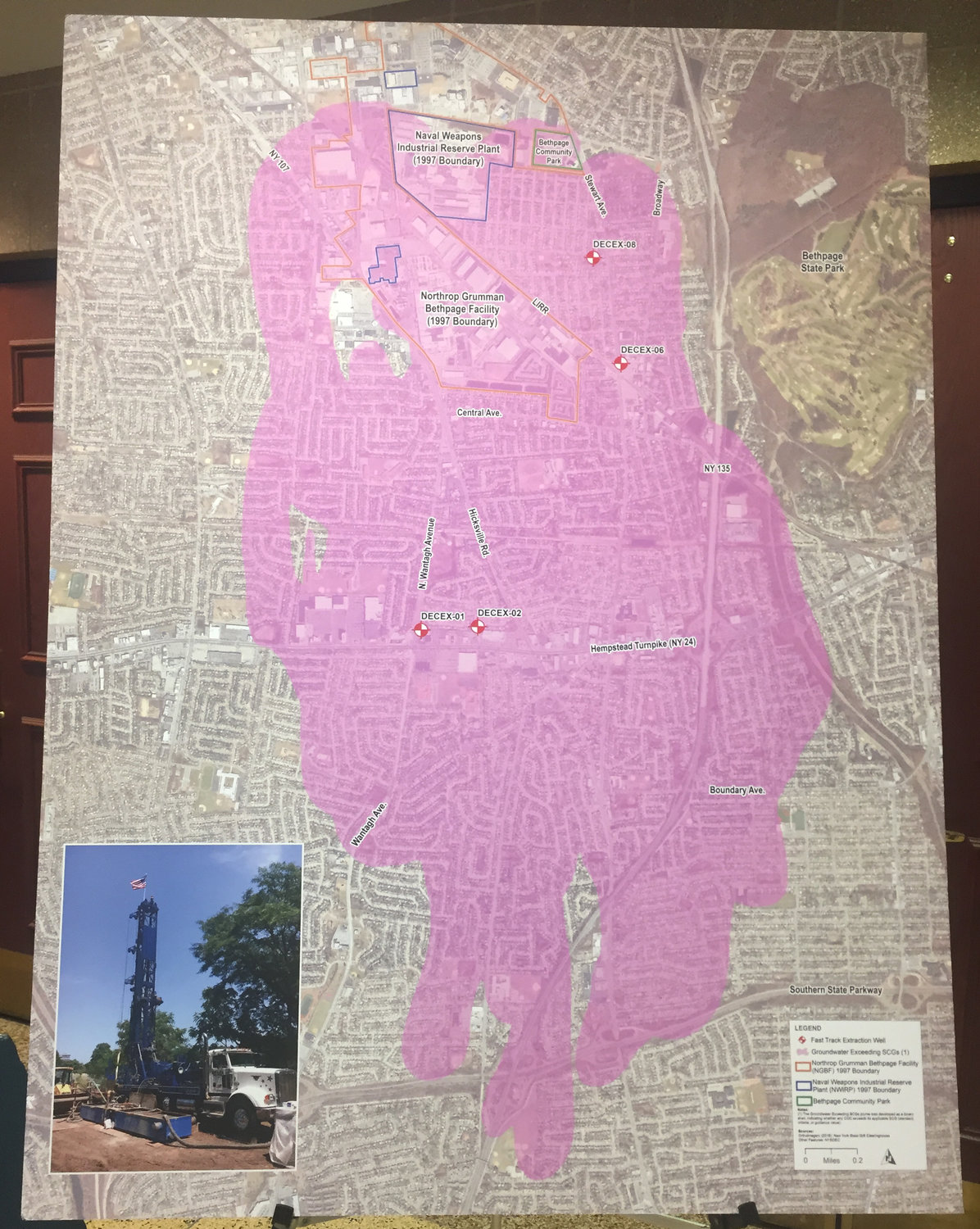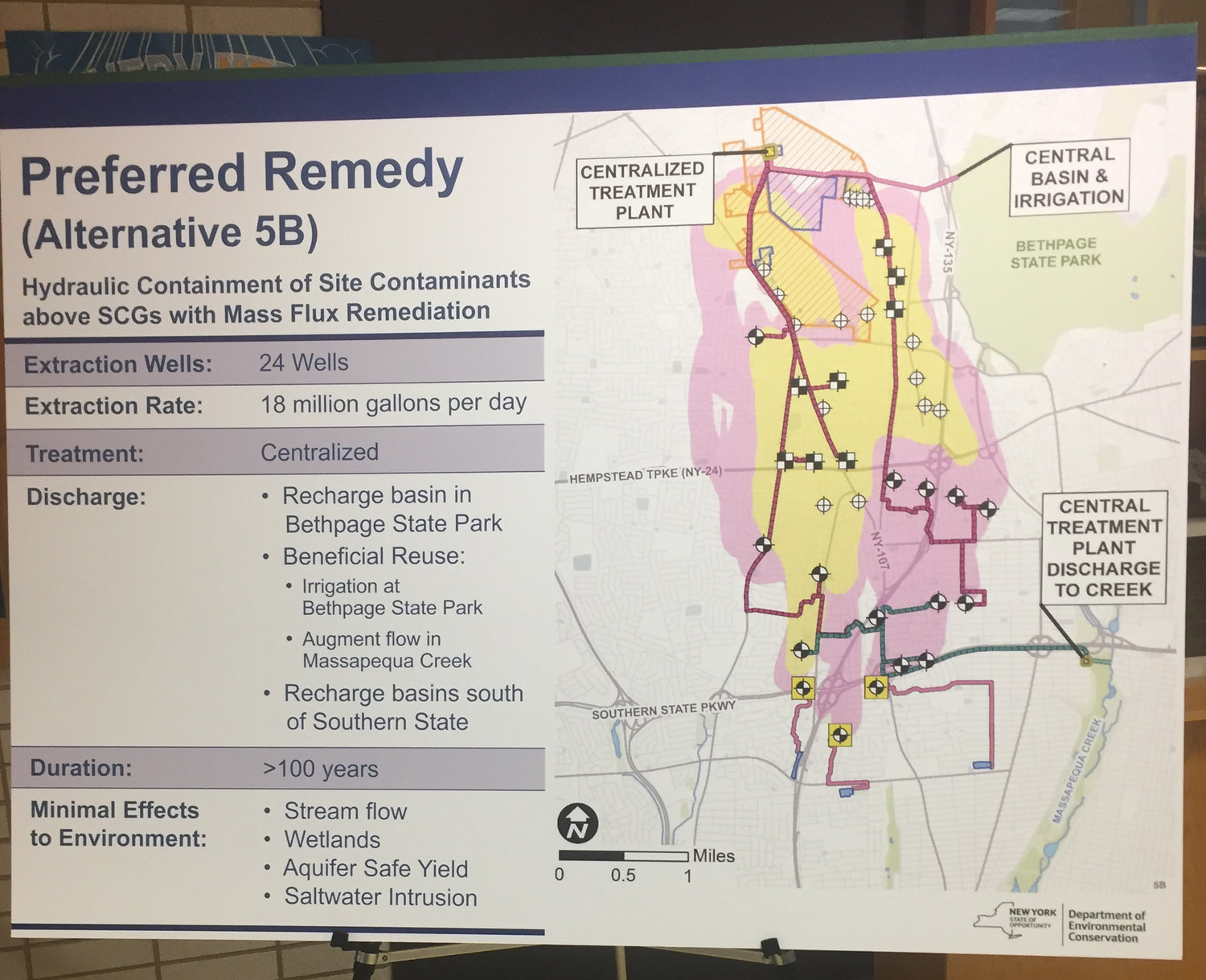State unveils ambitious plan for Bethpage toxic plume
Hundreds of people gathered in the auditorium at Bethpage High School on June 11 to learn about the ambitious proposal by the New York State Department of Environmental Conservation to contain and treat groundwater pollution from a chemical plume that has affected 11 public water supply wells and threatens another 16 as it moves slowly southward.
The state plan is the first major effort at remediation of what has become known as the Bethpage plume, which now extends as far south underground as the Southern State Parkway, west past Gardiners Avenue in Levittown and as far east as the Seaford-Oyster Bay Expressway. It already encompasses the northern halves of Seaford and Wantagh, and also affects customers in New York American Water’s Merrick District as well as the Massapequa and Bethpage districts. It is 4.3 miles long from north to south, 2.1 miles wide at its widest, and up to 900 feet deep.
Experts estimate that the plume is moving southward at a rate of about a foot per year.
The state hopes to clean up the immediate area where the wells are located, and to slow or halt the plume’s inexorable spread, according to the DEC’s deputy commissioner, Martin Brand. Costing a projected $585 million, it is not the most expensive of the plans put forward, but is the most aggressive, Brand said. Other plans range from $332 million to $748 million.
The state plans to recoup the cost through litigation against the entities allegedly responsible for the contamination: Northrop Grumman Corp. and the U.S. Navy, which joined Grumman to operate the Naval Weapons Industrial Reserve Plant and produced prototype and experimental aircraft under license to Grumman beginning in 1941. Two toxic plumes were discovered under the 605-acre Grumman/Navy site in 1986.
The DEC plan would cover 24 wells, 16 on the edge of the plume and eight pumping “hot spot” areas with the highest levels of contaminants. Two of the wells are located just north of Hempstead Turnpike in Levittown, between Wantagh Avenue and Hicksville Road.
The water that would be pumped out would be treated at recharge basins in Bethpage State Park and south of the Southern State Parkway. The treated water would augment irrigation at the state park as well as the flow of Massapequa Creek, Brand said.
“It’s a fantastic project and it’s a tremendous next step in the long-term remediation of the Navy Grumman plume here in the Bethpage area,” Brand said. “It’s a comprehensive plan and it will be difficult to implement, but it’s feasible to contain the plume.”
The DEC’s plan is expected to take five years to design and implement. It could take over 100 years, however, to remove all the contaminants.
“Overall, I think it’s a great plan,” said State Sen. John Brooks, a Democrat from Seaford. “I’ve talked with the folks running it, and I’m convinced they know what they’re doing and are on top of it.” The state has an “absolute commitment to get this done,” Brooks added. “It’s an enormous project, but now they’ve identified the main point of contamination, and real progress is being made.”
Brooks said he was hopeful that once the process begins to work, it will be easier to persuade Grumman and the Navy to take over and accept their responsibility. Water districts in the affected areas have been pushing the DEC for years to force the two entities to take part in a more aggressive cleanup plan.
“I think [this] is one of the better plans,” said John Coumatos, commissioner of the Bethpage Water District. “It’s the best opportunity we have right now for our town and South Farmingdale and Massapequa. We’re a team.” Referring to the plume, he added, “Get rid of the black cloud.”
“I’m certain that it will help” the area, said Stan Carey, superintendent of the Massapequa Water District. “This plan is very detailed, and it will capture the leading edge of the plume, which will protect all of our public supply wells.”
“I hope they can do it a little faster,” Carey added. “Five years is a long time considering all of the years that have gone by so far, so we’re hopeful they can expedite that.”
NYAW External Affairs Manager Lee Mueller said, “The protection of the Long Island aquifer, our sole source of drinking water, is critical, and New York American Water supports efforts to contain and treat groundwater pollution. Cleanup efforts benefit our customers and help reduce the financial burden of additional treatment that may be required to provide safe, clean drinking water.”
Residents arrived at last week’s meeting ready to discuss the new plan and share their experiences of living in and around the plume. “I’ve been going to these meetings since the late 1990s and nothing’s happening,” said Susan Spinato, of Bethpage. “So if they’re really going to do something, then do it.”
“For 20 years the Navy and Grumman have been wringing their hands and pointing their fingers and tap-dancing as fast as humanly possible,” said Gina McGovern, a longtime Bethpage resident, “and now New York state has apparently decided this is the plume, this is exactly where it is, and this it what we think should be done. We’re all so out of patience and out of trust at this point,” she added.
During the public comment section, more than 20 people stepped up to voice their concerns about health, the plan’s timing and getting Northrop Grumman and the U.S. Navy to step up.
“We don’t want state taxpayers to pay for the remedy,” Brand said after a number of speakers raised concerns about where money for the plan was coming from. “We want the polluters to pay for the remedy.”
The plume contains some two dozen contaminants, including TCE, a human carcinogen, and another, 1,4-dioxane, a likely carcinogen, which is harder to filter out of the water than other chemicals. According to the most recent water quality reports released by NYAW, however, no TCE was detected.
The DEC will accept public comments about the proposed plan until July 7.
Timothy Denton contributed to this story.

 47.0°,
Mostly Cloudy
47.0°,
Mostly Cloudy 








